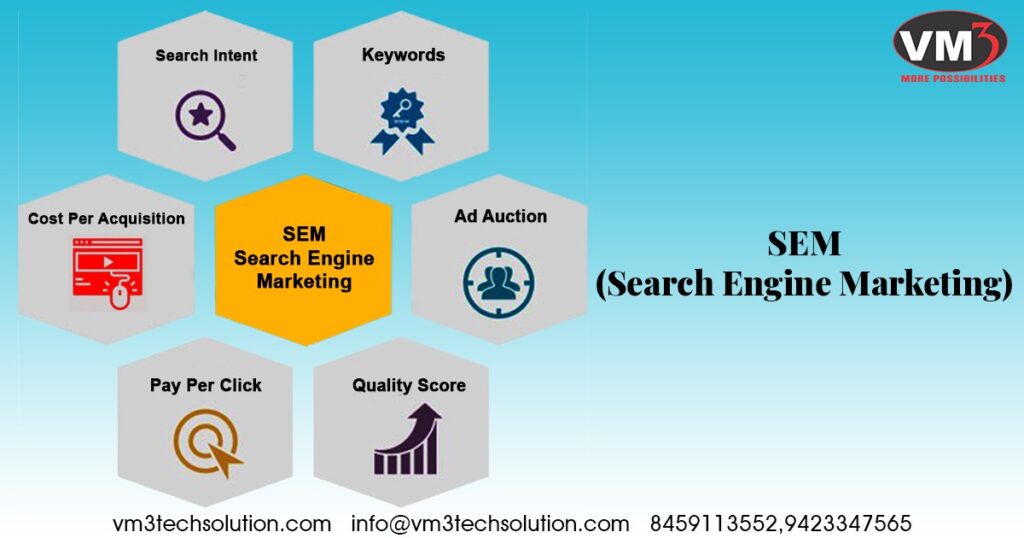Digital Marketing: SEM Search Engine Marketing
In Web-Development and SEO Search Engine Optimization blog, we’ve skilled improving organic reach through Website Development and SEO (Search Engine Optimization).
In tutorial today, we’ll undergo SEM (Search Engine Marketing). SEM is the practice of selling a business using paid advertisements that appear on program results pages. Advertisers bid on keywords that users of services like Google, Bing, Yahoo and Baidu might enter when trying to find certain products or services. These ads, often known by the term pay-per-click ads and pay per thousand impressions. These are available a spread of formats. Some are small, text-based ads, whereas others, like product listing ads are more visual. Product-based advertisements allow consumers to ascertain important information at-a-glance, like price and reviews.
In paid campaigning, you’ll reach additional people (inorganic reach) through different campaigns. While most of the small companies, businessman directly jump to paid campaigning (SEM) without having proper organic reach or basic SEO, they mostly get ineffective results as their website infrastructure isn’t ready for paid campaigning. Before even you begin any campaign, confirm basic security and basic SEO of your business done and analytical tools are integrated properly to your website. It’ll help to analyze results and also helps in lead generation.
SEM Strategy:
Paid Search Campaign strategy are often customized and decided to supported target customer base; season/off-season marketing, budget, location etc. It is often either Pay Per Click (PPC) or Pay per thousand impressions or lead generation campaign.
Keyword Strategy: SEM is especially counting on Keywords and Keyphrases. As users enter keywords as search queries, advertisement specified to those keywords are displayed. First, you would like to spot keywords, which are relevant to your business which prospective customers are likely to use when checking out your products and services. There are few free and a few paid tools to try for keyword analysis. In addition to helping you discover keywords, you ought to be bidding on, thorough keyword research.
Negative Keywords and Search Intent:
You also need to identify negative keywords – search terms that you simply should exclude from your campaigns. Negative keywords are irrelevant terms that are highly unlikely to end in conversions. For instance, if you sell Biryani, you would possibly want to exclude the keyword “Biryani recipes”, as users checking out Biryani recipes are unlikely to be within the marketplace for your product. This concept is understood as search intent for a given term.
Some keywords are considered to possess high commercial intent or a robust indication that the searcher wants to shop for something. samples of high commercial intent keywords include discounts, free shipping, best deals etc
Ad Auction:
While your advertising budget is advantageous, but it’s not the top formula for successful SEM. it’s because all ads undergo a process of ad auction before appearing alongside search results. Let’s discuss on the ad auction in Google AdWords. The ad auction conducted whenever the user enters an enquiry query into Google. To be entered into the ad auction, advertisers identify keywords they need to bid on and state what proportion they’re willing to spend (per click) to possess their ads to appear alongside results concerning those keywords. If Google determines that the keywords you’ve got bid on are contained within a user’s search query, your ads are entered into the ad auction. Two main factors that Google evaluates as a part of the ad auction process are your bid amount and quality score of your ad.
Google calculates these metrics during the ad auction to work out the placement of advertisements. The results of this calculation are understood as ad rank. Given that Google AdWords’ Quality Score comprises half the ad rank formula, it’s one among the foremost crucial metrics program marketers can specialize in.
Top-quality Scores can assist you to achieve better ad position at lower costs because Google favours ads that are highly relevant to user queries. It is possible that lowest bid advertiser can have the highest Quality Score, meaning their ads are given priority in terms of placement during the ad auction.
SEM methods:
1. PPC (pay-per-click): PPC advertising is the hottest sort of SEM. With PPC, the marketer only pays for the ad when a user clicks on the link. All the opposite times when the searcher sees the page but doesn’t click are liberal to the advertiser. P1rogram PPC advertising charges a little fee for every click, but the potential returns on investment (ROI) are much greater than the fee.
2. CPA (cost-per-acquisition)- Lead generation/conversion: Your CPA is that the total cost of your PPC campaign divided by the conversions you secured. Calculating your CPA will assist you to determine whether your paid SEM strategy is leading to a profit or costing quite you’re making. CPA can assist you to understand the financial impact of your marketing campaign. You’ll determine a suitable CPA by calculating the typical order value (AOV) and customer lifetime value (CLV) of your business. • CPM (cost-per-thousand-impressions). CPM refers to what proportion of 1,000 advertisement impressions on a webpage cost the marketer. For instance, if the location charges $10 CPM, meaning you’ll pay $10 for every 1,000 impressions of your ad. You’ll measure the ROI of your CPM campaign by analyzing your click-through rates, or how often users click your ad compared to the number of impressions.

